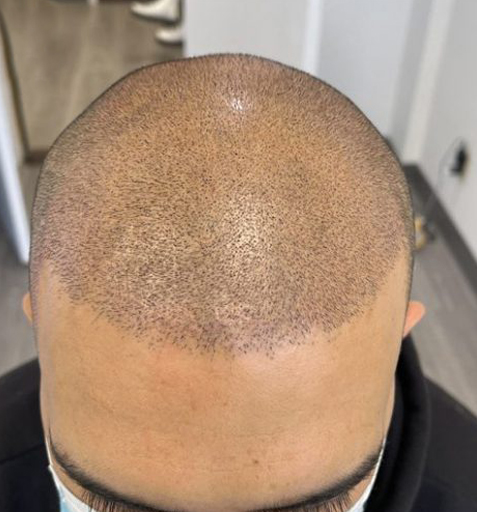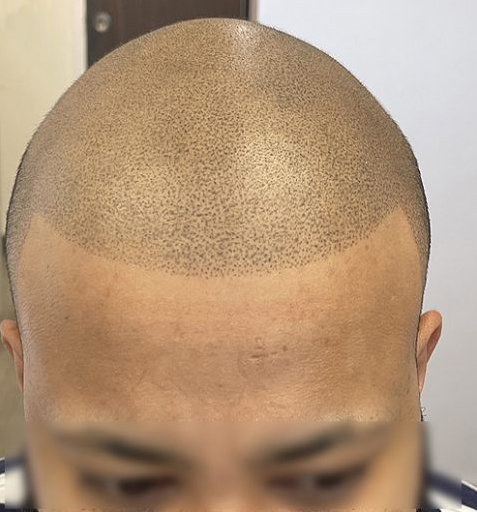A scalp tattoo creates the look of hair follicles on the scalp. This treatment makes hair look thicker and fuller. Technicians use special pigments to match your natural hair colour. This helps the tattoo blend well with your existing hair.
A scalp tattoo works well to make thin hair look fuller. The tiny dots on the scalp look like real hair. This treatment creates a natural appearance. Many people find it boosts their confidence.
Scalp micropigmentation is a treatment that mimics real hair follicles. The treatment uses pigments applied to the scalp. The procedure creates the look of short hair or a shaved head. This works well for people with hair loss or thinning.
Scalp micropigmentation looks real when done by a skilled technician. The pigment matches your hair and skin tone. The dots look like natural hair follicles. This gives the scalp a natural and realistic appearance.
Scalp micropigmentation is not noticeable when done correctly. The pigment blends seamlessly with your natural hair and skin, making the scalp micropigmentation visibility almost undetectable.
Scalp micropigmentation works by adding pigment to the scalp. A technician uses tiny needles to create small dots. These dots mimic the look of natural hair follicles. This gives the scalp a fuller and denser appearance.
The process involves applying pigment in multiple sessions. A technician uses fine needles to create detailed results. Each session adds layers of pigment for a realistic look. The treatment builds up over time for the best effect.
Each session of scalp micropigmentation takes about two to four hours. The time depends on the size of the area being treated. Most people need several sessions to complete the process. These sessions ensure the final result looks natural.
Scalp micropigmentation offers a non-surgical option for hair loss. It creates a realistic appearance without long recovery times. The treatment is low maintenance and lasts for years. Many people choose it to improve their confidence and appearance.
Scalp micropigmentation makes thinning hair look fuller. The treatment gives the scalp a denser and more complete appearance. This option works well for people wanting a natural look. The results help cover areas where hair is thin.
People with hair loss, thinning hair, or scars on the scalp are good candidates. The treatment works for different hair conditions. A consultation helps decide if the treatment fits your needs. Technicians adjust the procedure to match individual goals.
Aftercare involves keeping the scalp clean and dry. Avoid sunlight and harsh products during the healing phase. Proper aftercare helps the pigments settle well. Following instructions from the technician ensures good results.
Scalp micropigmentation carries very few risks when done correctly. Some people may experience slight redness or irritation. Choosing a qualified technician reduces the chance of problems. The risks are usually temporary and minor.
Scalp micropigmentation fades naturally over several years. The fading depends on factors like skin type and sun exposure. Touch-up sessions restore the original look. This keeps the scalp looking full and natural.
Scalp micropigmentation can be removed or lightened. Laser treatments work to erase unwanted pigments. This option helps people who want changes to their treatment. A technician can guide you through the process.
Scalp micropigmentation works for all hair types and colours. Technicians match the pigment to your natural shade. This makes the treatment suitable for most people. The results look realistic no matter your hair texture or tone.
Most people feel little pain during scalp micropigmentation. Numbing creams make the process more comfortable. Some may feel mild discomfort, but it is tolerable. Many consider the results worth the temporary sensation.
Scalp micropigmentation helps people with alopecia. The treatment creates the look of hair follicles on the scalp. This improves the appearance of areas without hair. Many people with alopecia choose this option for its natural results.
The cost of scalp micropigmentation depends on the area treated. Clinics with more experience may charge higher fees. A consultation provides a clear estimate of the price. The investment gives lasting and high-quality results.
Scalp micropigmentation offers a quick and realistic solution for hair loss. The treatment does not involve surgery or long recovery times. Many people choose this option for its natural look. It provides an effective way to improve confidence and appearance.
We recommend 5-7 days after your 1st treatment to commence the 2nd treatment. This allows the tiny scabs to fall off, and some fading occurs to access the next treatment density and shading levels. The third treatment should also be done 5-7 days after the 2nd treatment, but this can be extended to 2 to 4 weeks after the 2nd treatment, at the practitioner’s discretion. Any following treatments would be scheduled after 30 days to assess overall fading and density levels.
Ideally the 2nd treatment is scheduled 7 days after the first, and with the 3rd treatment (if necessary) coming 30 days after the 2nd treatment.
Normally, 2 to 3 treatments are required. Some alopecia and hair transplant clients may require more. Each treatment takes between 30 minutes to 4 hours depending on the amount of area that needs to be treated. The whole scalp area is done with each treatment. We do not do just half a scalp during one treatment as the pigment or pressure of the needle may be slightly different from one treatment to the next.
Thank-you for visiting our SMP hair FAQ. Contact Us Today to Schedule YOUR FREE In-Clinic Consultation!






© 2024 HAIRTATTOO.CA | Scalp Micropigmentation & Trichology Centre
